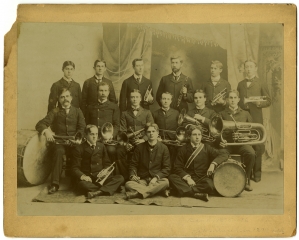circulars for the Geology Department and prepared the University’s first viewbook which was issued for distribution at Colgate’s prize-winning exhibit at the Columbian Exposition at Chicago in 1893. The format of the Catalogues was modernized.
The trips of the musical and dramatic groups, too, reached a rather wide public and Patrons’ Day and Commencement Week brought large numbers of friends and graduates to the campus.
Colgate constituencies had cause for genuine satisfaction in the University’s vigorous condition and accomplishments as the ’90’s drew to a close. Though there had been no president for most of the decade, morale was good and James C. Colgate and members of the faculty had given wise leadership. Administrative reforms promoted efficiency and the Dodge Fund contributed to financial stability. Landscaping and a new gymnasium were changing. the appearance of the campus. Lively and progressive professors updated and improved the courses of study and enthusiastic students took pride in their fraternities, athletics and expanding extracurricular activities. There was ample justification for expecting continued prosperity as the University stood on the threshold of the new century.






